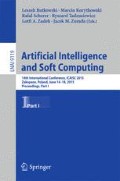Abstract
Active Learning (AL) is an emerging field of machine learning focusing on creating a closed loop of learner (statistical model) and oracle (expert able to label examples) in order to exploit the vast amounts of accessible unlabeled datasets in the most effective way from the classification point of view.
This paper analyzes the problem of multiclass active learning methods and proposes to approach it in a new way through substitution of the original concept of predefined utility function with an ensemble of learners. As opposed to known ensemble methods in AL, where learners vote for a particular example, we use them as a black box mechanisms for which we try to model the current competence value using adaptive training scheme.
We show that modeling this problem as a multi-armed bandit problem and applying even very basic strategies bring significant improvement to the AL process.
Access this chapter
Tax calculation will be finalised at checkout
Purchases are for personal use only
Preview
Unable to display preview. Download preview PDF.
References
Alimoglu, F., Alpaydin, E.: Methods of combining multiple classifiers based on different representations for pen-based handwritten digit recognition. In: Proceedings of the Fifth Turkish Artificial Intelligence and Artificial Neural Networks Symposium (TAINN 1996). Citeseer (1996)
Auer, P.: Using confidence bounds for exploitation-exploration trade-offs. Journal of Machine Learning Research 3, 397–422 (2003)
Auer, P., Cesa-Bianchi, N., Fischer, P.: Finite-time analysis of the multiarmed bandit problem. Machine Learning 47(2-3), 235–256 (2002)
Auer, P., Cesa-Bianchi, N., Freund, Y., Schapire, R.E.: The nonstochastic multiarmed bandit problem. SIAM Journal on Computing 32(1), 48–77 (2003)
Breiman, L.: Bagging predictors. Machine Learning 24(2), 123–140 (1996)
Breiman, L.: Random forests. Machine Learning 45(1), 5–32 (2001)
Carpentier, A., Lazaric, A., Ghavamzadeh, M., Munos, R., Auer, P.: Upper-confidence-bound algorithms for active learning in multi-armed bandits. In: Kivinen, J., Szepesvári, C., Ukkonen, E., Zeugmann, T. (eds.) ALT 2011. LNCS, vol. 6925, pp. 189–203. Springer, Heidelberg (2011)
Clark, C., Storkey, A.: Teaching deep convolutional neural networks to play go. arXiv preprint arXiv:1412.3409 (2014)
Crammer, K., Singer, Y.: On the algorithmic implementation of multiclass kernel-based vector machines. The Journal of Machine Learning Research 2, 265–292 (2002)
Czarnecki, W.M., Podolak, I.: Adaptive active learning as a multi-armed bandit problem. Frontiers in Artificial Intelligence and Applications, pp. 989–990 (2014)
Fernández-Delgado, M., Cernadas, E., Barro, S., Amorim, D.: Do we need hundreds of classifiers to solve real world classification problems? The Journal of Machine Learning Research 15(1), 3133–3181 (2014)
Gelly, S., Silver, D.: Monte-Carlo tree search and rapid action value estimation in computer Go. Artificial Intelligence 175(11), 1856–1875 (2011)
Haussler, D.: Learning conjunctive concepts in structural domains. Machine Learning 4(1), 7–40 (1994)
Huang, G.B., Zhu, Q.Y., Siew, C.K.: Extreme learning machine: theory and applications. Neurocomputing 70(1), 489–501 (2006)
Krizhevsky, A., Hinton, G.: Learning multiple layers of features from tiny images. Computer Science Department, University of Toronto, Tech. Rep. (2009)
Kuleshov, V., Precup, D.: Algorithms for the multi-armed bandit problem. Journal of Machine Learning Research 1, 397–422 (2000)
Lai, T.L., Robbins, H.: Asymptotically efficient adaptive allocation rules. Advances in Applied Mathematics 6(1), 4–22 (1985)
LeCun, Y., Cortes, C.: Mnist handwritten digit database. AT&T Labs [Online] (2010), http://yann.lecun.com/exdb/mnist
Li, L., Chu, W., Langford, J., Schapire, R.E.: A contextual-bandit approach to personalized news article recommendation. In: Proceedings of the 19th International Conference on World Wide Web, pp. 661–670. ACM (2010)
Ou, G., Murphey, Y.L.: Multi-class pattern classification using neural networks. Pattern Recognition 40(1), 4–18 (2007)
Pedregosa, F., Varoquaux, G., Gramfort, A., Michel, V., Thirion, B., Grisel, O., Blondel, M., Prettenhofer, P., Weiss, R., Dubourg, V., et al.: Scikit-learn: Machine learning in python. The Journal of Machine Learning Research 12, 2825–2830 (2011)
Podolak, I.T., Roman, A.: Theoretical foundations and experimental results for a hierarchical classifier with overlapping clusters. Computational Intelligence 29(2), 357–388 (2013)
Robbins, H.: Some aspects of the sequential design of experiments. In: Lai, T., Siegmund, D. (eds.) Herbert Robbins Selected Papers, pp. 169–177. Springer, New York (1985)
Settles, B.: Active Learning, vol. 6. Morgan & Claypool Publishers (2012)
Seung, H.S., Opper, M., Sompolinsky, H.: Query by committee. In: Proceedings of the Fifth Annual Workshop on Computational Learning Theory, COLT 1992, pp. 287–294. ACM (1992)
Sindhwani, V., Melville, P., Lawrence, R.D.: Uncertainty sampling and transductive experimental design for active dual supervision. In: Proceedings of the 26th Annual International Conference on Machine Learning, ICML 2009, pp. 953–960. ACM (2009)
Xu, Z., Akella, R., Zhang, Y.: Incorporating diversity and density in active learning for relevance feedback. In: Amati, G., Carpineto, C., Romano, G. (eds.) ECIR 2007. LNCS, vol. 4425, pp. 246–257. Springer, Heidelberg (2007)
Author information
Authors and Affiliations
Corresponding author
Editor information
Editors and Affiliations
Rights and permissions
Copyright information
© 2015 Springer International Publishing Switzerland
About this paper
Cite this paper
Czarnecki, W.M. (2015). Adaptive Active Learning with Ensemble of Learners and Multiclass Problems. In: Rutkowski, L., Korytkowski, M., Scherer, R., Tadeusiewicz, R., Zadeh, L., Zurada, J. (eds) Artificial Intelligence and Soft Computing. ICAISC 2015. Lecture Notes in Computer Science(), vol 9119. Springer, Cham. https://doi.org/10.1007/978-3-319-19324-3_38
Download citation
DOI: https://doi.org/10.1007/978-3-319-19324-3_38
Publisher Name: Springer, Cham
Print ISBN: 978-3-319-19323-6
Online ISBN: 978-3-319-19324-3
eBook Packages: Computer ScienceComputer Science (R0)

